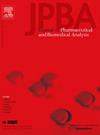基于末端脱氧核苷酸转移酶(TdT)的无模板信号放大技术,用于检测 MUC1 阳性细胞中的外泌体。
IF 3.1
3区 医学
Q2 CHEMISTRY, ANALYTICAL
Journal of pharmaceutical and biomedical analysis
Pub Date : 2024-10-20
DOI:10.1016/j.jpba.2024.116539
引用次数: 0
摘要
Mucin1 (MUC1) 蛋白参与细胞保护和信号通路,在各种癌症中异常升高,成为癌症的一个关键指标。外泌体反映了其起源细胞的状态,具有诊断癌症的潜力。因此,开发一种检测 MUC1 阳性外泌体的方法对于某些癌症的早期诊断至关重要。在这项研究中,我们利用末端脱氧核苷酸转移酶(TdT)开发了一种高灵敏度、特异性和简单的紫外可见信号放大方法来检测MUC1阳性外泌体。首先,使用 CD63 aptamer(apt)将外泌体捕获到磁珠上。然后,我们用低pH加载法合成的Primer-AuNPs-MUC1 apt复合物与外泌体表面的MUC1蛋白相连,形成三明治结构。TdT 催化生物素-dATP 在引物 3' 端延伸,将多个生物素位点引入夹层结构。这些位点随后与多个链霉亲和素-辣根过氧化物酶(链霉亲和素-HRP)结合,后者催化底物氧化变色,可通过比色法检测。该方法可检测到1.4E+6至4.2E+8颗粒/毫升的A549外泌体,并对不同MUC1表达的细胞株具有高度特异性。此外,该方法还在临床血清检测中成功区分了胆管癌(CCA)患者(11人)和健康人(7人),在实际样品检测中表现出良好的性能。本文章由计算机程序翻译,如有差异,请以英文原文为准。
Terminal deoxynucleotidyl transferase (TdT) based template-free signal amplification for the detection of exosomes in MUC1-positive cells
The Mucin1 (MUC1) protein, involved in cytoprotective and signaling pathways, is abnormally elevated in various cancers, making it a key cancer indicator. Exosomes, which reflect the status of their originating cells, offer potential for cancer diagnosis. Thus, developing a method to detect MUC1-positive exosomes is crucial for the early diagnosis of certain cancers. In this study, we developed a highly sensitive, specific, and simple UV–visible signal amplification method to detect MUC1-positive exosomes using terminal deoxynucleotidyl transferase (TdT). Initially, exosomes were captured on magnetic beads using a CD63 aptamer(apt). The Primer-AuNPs-MUC1 apt complex which we synthesized by low pH loading method was then attached MUC1 proteins on the surface of the exosomes to create a sandwich structure. TdT catalyzed the extension of Biotin-dATP at the 3′ end of the primer, introducing multiple biotin sites into the sandwich structure. These sites subsequently bound multiple streptavidin-horseradish peroxidase (streptavidin-HRP), which catalyzed the oxidative color change of the substrate, which can be detected by colorimetric method. This method can detect A549 exosomes in the range of 1.4E+6 to 4.2E+8 particles/mL and shows high specificity for cell lines with different MUC1 expression. Additionally, it successfully distinguished cholangiocarcinoma (CCA) patients (n=11) from healthy individuals (n=7) in clinical serum assays, demonstrating good performance in real sample detection.
求助全文
通过发布文献求助,成功后即可免费获取论文全文。
去求助
来源期刊
CiteScore
6.70
自引率
5.90%
发文量
588
审稿时长
37 days
期刊介绍:
This journal is an international medium directed towards the needs of academic, clinical, government and industrial analysis by publishing original research reports and critical reviews on pharmaceutical and biomedical analysis. It covers the interdisciplinary aspects of analysis in the pharmaceutical, biomedical and clinical sciences, including developments in analytical methodology, instrumentation, computation and interpretation. Submissions on novel applications focusing on drug purity and stability studies, pharmacokinetics, therapeutic monitoring, metabolic profiling; drug-related aspects of analytical biochemistry and forensic toxicology; quality assurance in the pharmaceutical industry are also welcome.
Studies from areas of well established and poorly selective methods, such as UV-VIS spectrophotometry (including derivative and multi-wavelength measurements), basic electroanalytical (potentiometric, polarographic and voltammetric) methods, fluorimetry, flow-injection analysis, etc. are accepted for publication in exceptional cases only, if a unique and substantial advantage over presently known systems is demonstrated. The same applies to the assay of simple drug formulations by any kind of methods and the determination of drugs in biological samples based merely on spiked samples. Drug purity/stability studies should contain information on the structure elucidation of the impurities/degradants.

 求助内容:
求助内容: 应助结果提醒方式:
应助结果提醒方式:


